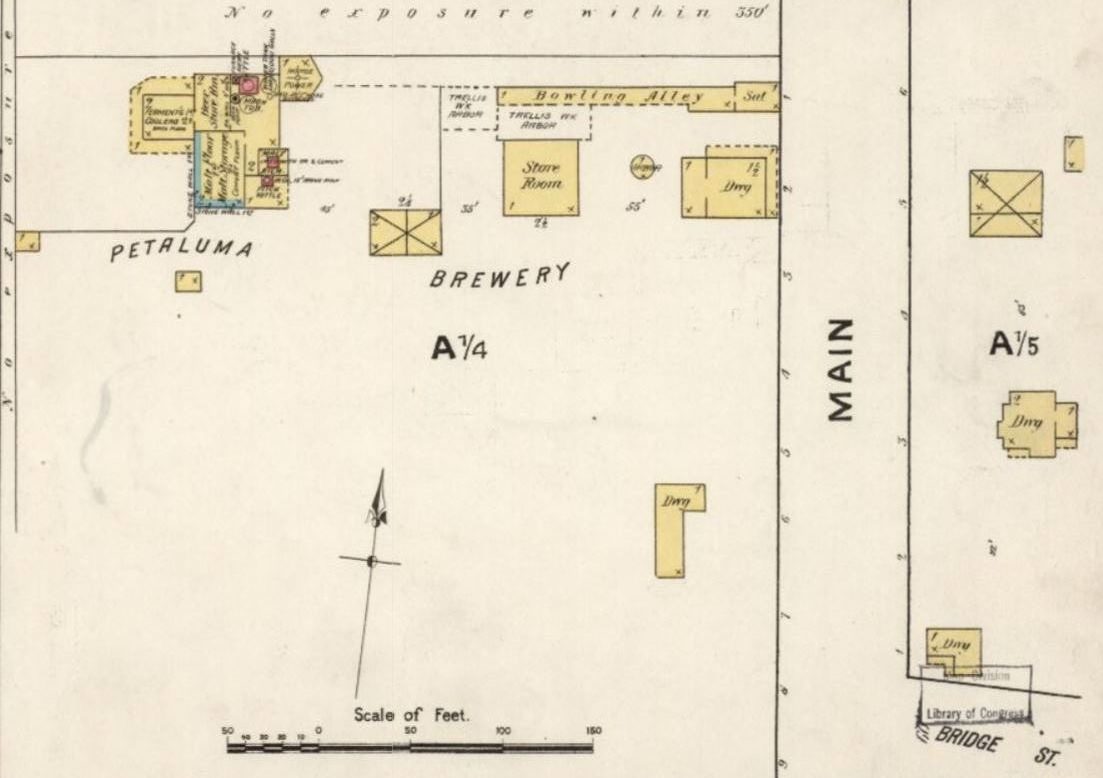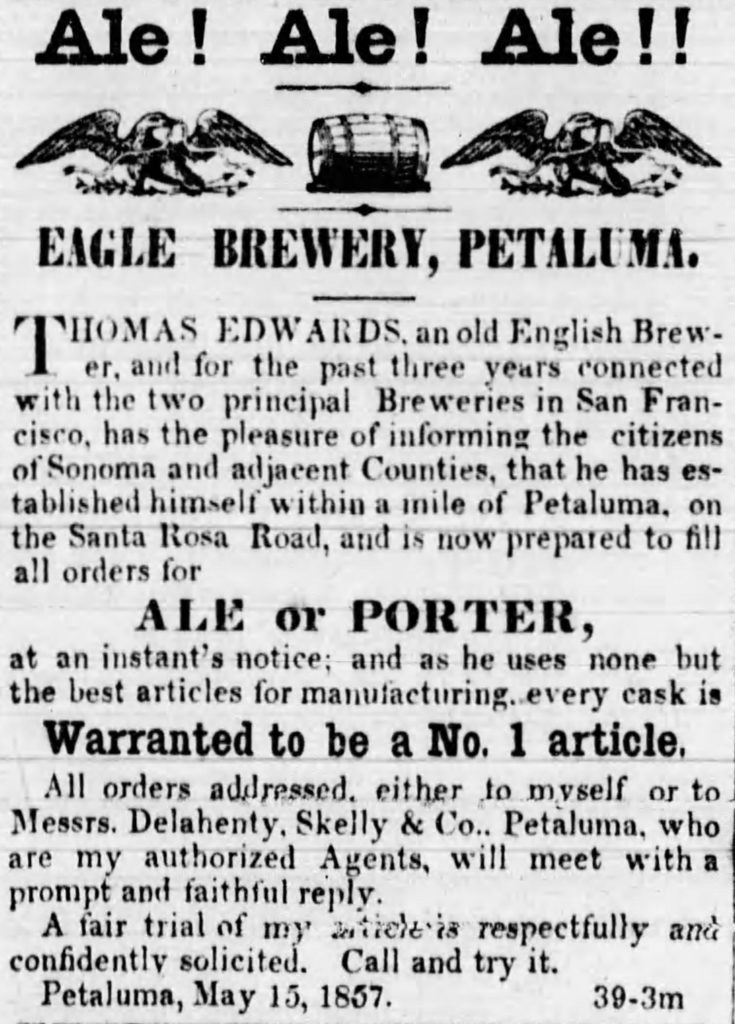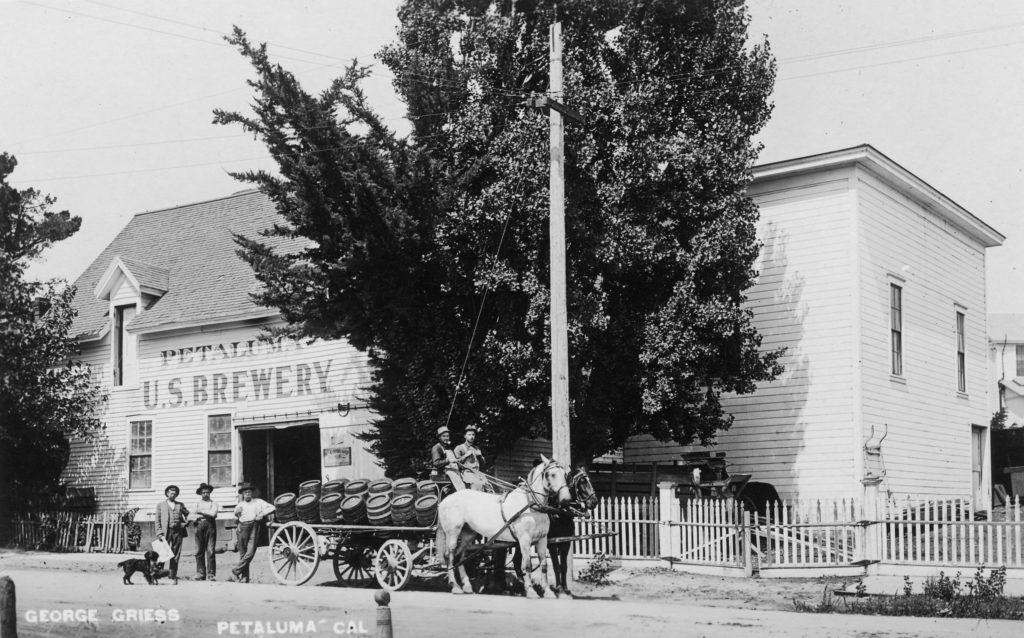Petaluma’s popularity as a hotspot for beer enthusiasts began long before the current craft beer renaissance. During the 19th century, Sonoma County’s southernmost town was home to several breweries – the first of which was established in 1855 by Frederick Christlich on North Main (today’s Petaluma Boulevard North) at West Street. The Petaluma Brewery, as it was aptly named, was not only the first Petaluma brewery, but also the first Sonoma County brewery.
After a succession of owners, the brewery was purchased by George Robuson in 1873. Robuson added gardens and shade arbors that transformed the existing brewery, saloon, and bowling alley into a destination that could be enjoyed by the whole family.

By 1875 the Petaluma Brewery employed four men and was making 25,000 to 30,000 gallons of beer annually, with deliveries being made daily by wagon to Sonoma, Novato, and various other localities.
In addition to producing beer, the Petaluma Brewery served as a social and meeting hall. On April 24, 1873, a “Grand Ball” was attended by “about thirty ladies and gentlemen of our German citizens.” Dancing and singing lasted throughout the night according to local papers.
Members of the Turn Verein Society, an athletic, social and political organization founded by German immigrants, met weekly at the Petaluma Brewery until their hall was completed in 1874, on Fourth Street between C and D Streets (now the site of Bank of the West). On June 1, 1879, the “Turners” hosted their annual festival at the Petaluma Brewery Gardens. The program included music provided by a San Francisco band, dancing, turning (aka gymnastics), nine-pin rolling, foot races for “ladies, gents and boys,” and other games.
By 1880, the Petaluma Brewery produced twelve hundred barrels of beer annually, which were distributed throughout Sonoma and adjacent counties.
Following George Robuson’s death in 1883, his widow, Caroline Robuson, leased the brewery to her husband’s former partner, Jurgen Gerckens. Robuson and Gerckens had also run the Union Hotel on Petaluma’s Main Street.
The Petaluma Brewery burned to the ground in 1889. In 1895 Caroline Robuson sold the North Main Street property to George F. Fischer, who operated a winery on the site for several years.
While the Petaluma Brewery had a pretty long run – 1855 to 1889, it wasn’t the only game in town. Thomas Edwards opened his Eagle Brewery in 1857 on property, which is currently occupied by the Petaluma Village Premium Outlets, about one mile north of the Petaluma Brewery.
Advertisements for the Eagle Brewery describe Thomas Edwards as “an old English brewer,” connected with two principal San Francisco breweries. Edwards operated the Eagle Brewery until he died in 1872. After sitting unoccupied for three years, the brewery was torn down in 1875.

Perhaps filling a void left by the Eagle Brewery’s loss, Charles Micheli and George Griess opened the Sonoma Brewery at the corner of Upham and Stanley Streets. As of 1875, the brewery produced 15,000 to 20,000 gallons of beer and sixty tons of malt annually.
In 1877, the capacity of the Sonoma Brewery and the Petaluma Brewery was about 81,000 gallons annually. They used 200 cords of wood, 850 tons of barley, 12 tons of hops, mostly California grown.
Many of those California hops were likely grown locally. In the 1870s, hops were one of Sonoma County’s top cash crops. Hops thrived in places like Healdsburg, Windsor, and Santa Rosa. By 1899 Sonoma County led the world in hop production.
In 1884 and 1885, the Sonoma Brewery advertised the availability of Culmbacher Lager Bear and Extra Stout Dublin Porter, which could be “put up and delivered in pint and quart bottles expressly for family use.” Orders were picked up at the Sonoma Beer Depot, located at the foot of Western Avenue, where manager John Andrews sold beer for 5 cents a glass.
The Sonoma Brewery was shuttered and about to be foreclosed upon when it was destroyed by an alleged arsonist in 1887. The Petaluma Weekly Argus reported that “the firemen responded with their usual alacrity, but were unable to do more than prevent the flames from reaching other buildings. It was an old wooden structure, dry as tinder, and evidently burned to the delight of the person who set it on fire.”

Courtesy of the Museum of Sonoma County
George Griess sued to recover $2,250 on an insurance policy and went on to open the United States Brewery on Upham Street at Bodega Avenue. The first brew of “sparkling, amber liquid was drawn from a huge vat into kegs” on December 5, 1895. A Petaluma Argus article reported in 1907 that Griess’ brewery had a capacity of 40 barrels per day, and plans to enlarge the plant and double production were in the works. In addition to brewing beer, Griess also distilled brandy.
Following Griess’ death in 1914, the brewery continued to operate under a handful of leasees until it was sold to Santa Rosa’s Grace Brothers in 1917 who, despite investing in several improvements, closed the plant in April of 1918 – just months before the U.S. Congress passed the temporary Wartime Prohibition Act. The purpose of the act was to conserve grain for the war effort.
Sixty-seven years would pass before another brewery was established in Petaluma. On November 30, 1985, Jeff Berrington opened the Redwood Brewing Company which operated at the site of the former KTOB studios at 21 Washington Street.
Today, Petaluma is home to several indoor-outdoor, family-friendly beer gardens, including Demsey’s Restaurant & Brewery, HenHouse Brewing Company, Brewster’s Beer Garden, and Lagunitas Brewing Company, each loosely following the business model established in the 19th century by George Robuson and other early Petalumans.
Notes:
Research assistance provided by Sharon Ridley-Smith. Sharon’s compilation of primary and secondary documentation relating to Petaluma breweries is on file at the Sonoma County History & Genealogy Library – Call No. Annex R 663.42 Ridley-Smith.
A version of this article first appeared in the October 2020 edition of the Sonoma-Marin Farm News. The idea to write about beer in October was based on my mistaken belief that October is when Oktoberfest occurs. It turns out that the majority of Oktoberfest takes place in September!
